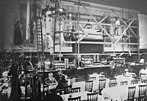Arnold Fiechter
Arnold Fiechter (born July 18, 1879 in Sissach ; † April 5, 1943 in Basel ; legal resident in Böckten ) was a Swiss painter and teacher at the trade school in Basel.
life and work
Arnold Fiechter grew up with his sister Elise (1875–1962) in Sissach for the first twelve years. After the early death of his mother in 1891, his father, Arnold Fiechter-Niederhauser, who worked as a master weaver of ribbons, married the widow Elisabeth Schneider. A short time later they moved to Kleinbasel .
With his childless uncle, Arnold Fiechter completed an apprenticeship as a flat painter in Sarnen from 1894 to 1897 and worked as a decorative painter in Central Switzerland .
He then studied at the Basel vocational school under Fritz Schider and met Alfred Bloesch (1890–1967), with whom he had a lifelong friendship. Arnold Fiechter was barely 20 years old and was able to exhibit his watercolors in the Kunsthalle Basel .
First study trips to Paris, southern France and Italy followed. From 1902 to 1903 Arnold Fiechter studied with Hermann Groeber and from 1906 to 1911 with Moritz Heymann in Munich.
From 1911 Arnold Fiechter worked as a painter in Basel. His preferred motifs were mainly landscape and everyday scenes from the area around Basel, the Jura and Markgräflerland . His style was representational with influences from Paul Gauguin and Paul Cézanne , Ferdinand Hodler and Cuno Amiet . Until 1908 Arnold Fiechter mainly painted watercolors, later oil paintings were added. In 1913 he was invited to a watercolor exhibition in Dresden . In 1913 and 1914 he received a federal art grant .
Arnold Fiechter developed his own color theory based on Goethe's theory of colors . From 1915 to 1943 he was the main teacher in the painting classes at the Basel Business School. His successor was the painter Haiggi Heinrich Müller (1885–1960). Many of the Basel artists, including Jean-François Comment , Kurt Volk , Irène Zurkinden , Jakob Strasser , Hans Weidmann , Max Kämpf , Hermann Anselment , Albert Schnyder or Hamid Zaki (1909–1968), were taught by Arnold Fiechter.
In 1922 Arnold Fiechter received an order from the Kunstkredit Basel-Stadt to create a mural in the station buffet hall of 1st class in Basel. Since his studio was too small for this work, he rented a hall in the sample fair . There he worked on the triptych oil painting Das Gastmahl for the next four years . (600 cm × 700 cm, 2 × 170 cm × 370 cm). The mural shows the strong influence of Italian Quattrocento painting, which served as a model for many Basel artists at the time. The painting suffered great damage due to moisture and was removed and only restored in 1953, mounted on individual panels and reinstalled in its old location.

In 1935 Arnold Fiechter exhibited ninety-eight of his pictures, which spanned the years 1909 to 1935, in an exhibition supervised by Lucas Lichtenhan at the Kunsthalle Basel.
Arnold Fiechter bequeathed several large-format pictures to the canton of Baselland . He found his final resting place with his sister Elise Fiechter (1875–1962) in the Hörnli cemetery .
literature
- Barbara Suter: Arnold Fiechter, the painter , Baselbieter Heimatbuch, Vol. 5, 1950, pp. 175-184
Web links
- Fiechter, Arnold In: Sikart
- Arnold Fiechter In: Catalog of cultural goods of the Canton of Basel-Landschaft
- Arnold Fiechter In: Artnet
- Arnold Fiechter In: Personal Lexicon of the Canton of Basel-Country
- Arnold Fiechter In: Swissbib
- Arnold Fiechter In: E-Periodica
- Arnold Fiechter In: Basler Stadtbuch
Individual evidence
- ↑ Dorothea Christ : Das Gastmahl, wall painting. Retrieved October 26, 2019 .
| personal data | |
|---|---|
| SURNAME | Fiechter, Arnold |
| BRIEF DESCRIPTION | Swiss painter and teacher at the trade school in Basel |
| DATE OF BIRTH | July 18, 1879 |
| PLACE OF BIRTH | Sissach |
| DATE OF DEATH | April 5, 1943 |
| Place of death | Basel |

